Changes in lipid levels and types can be corrected by topically applying agents to manipulate the lipid synthesis process within the viable epidermis. However, as described above, in dry skin conditions the epidermis makes less phytosphingosine-containing ceramides, changes the carbon chain lengths of other sphingoid bases and synthesis less long chain fatty acids. These results suggest that changes in the levels or activities of the different fatty acid synthetases, as well as the enzymes involved in phytosphingosine synthesis, occur in dry skin. The biology of these enzymes is yet to be described in these conditions.
Elias et al. (129), however, has used lipid mixtures to aid barrier recovery in acetone damaged barrier studies. Cholesterol itself was shown to aid barrier recovery in a tape stripping model in aged skin but not young skin. In fact any incomplete mixture of one or two of the three major lipid species slows barrier recovery in this model. The equimolar mixture of the three dominant SC lipids allows normal rates of barrier recovery in normal skin, whereas its further adjustment to a 3:1:1 molar ratio accelerates barrier recovery. As expected the requirements for optimal barrier recovery in aged skin is different, and it has been shown that a cholesterol dominant lipid mixture accelerates barrier recovery in aged skin whereas a fatty acid dominant mixture delays barrier recovery. In young skin any of the lipid species can be the dominant lipid and the barrier will recover more quickly with one exception, and that is in atopic dermatitis where a ceramide dominant mixture is required (130). Further studies on the use of long chain fatty acids are recommended. Exploiting these facts it has been shown that (131) mevalonic acid, the product of the rate limiting enzyme HMGCoA reductase, increases cholesterol biosynthesis.
Several other routes have been shown to increase ceramide synthesis in vivo and improve barrier function. As described above alpha-hydroxy acids well known for their desquamatory properties also stimulate lipid biosynthesis. Lactic acid, and especially the L isomer, increases ceramide biosynthesis in vitro and in vivo. Presumably lactic acid achieves this by acting as a general lipid precursor by providing acetate and providing more reducing power in the form of NADH or NADPH (132). Corresponding improvements in barrier function were reported. Interestingly, lactic acid also increased the levels of linoleate-containing CER EOS which may be contributing to these improvements in skin functionality.
The pleotropic skin benefits of niacinamide have been the subject of intense study by Procter & Gamble and have been excellently reviewed by Matts et al. (133). Niacinamide has been reported to stimulate the synthesis of glucosylceramides, sphingomeylin, cholesterol, and fatty acids by keratinocytes in vitro (127). The increases in ceramide synthesis were achieved by enhancing the activity of SPT together with the expression of
|
Lipids |
Optimized mixtures of ceramides, cholerterol & fatty acids |
|
Lipid precursors |
Phytosphingosine, tetra-acetylphytosphingosine, omega-hydrosy-fatty acides, linoleic acid |
|
Alpha-hydroxy acids |
L-Lactic acid |
|
Humectants |
Glycerol, urea |
|
Vitamins |
Niacinamide, lipoic acid, ascorbic acid |
|
Protease inhibitors |
Aminocyclohexanecarboxylic acid, egg white lysozyme |
|
Monerals |
Magnesium, calcium |
|
Histamine receptor |
H1 receptor antagonist |
|
Antagonists |
H2 receptor antagonist |
|
PPAR |
PPAR alpha agonists |
|
Electrical potential |
Negative potential |
|
Triterpenoids |
Ursolic acid |
|
GABA agonists |
GABA type A agonists (musimol, isoguvacine) |
|
Purinergic receptor |
P2Y antagonists |
|
Fragrances |
Fragrances |
|
GC receptor |
Glucocorticoid receptor antagonists |
|
Table 2 Agents That Increase Ceramide Biosynthesis |
LCB 1 and 2. In vivo, however, increased levels of stratum corneum fatty acid (67%) and ceramide (34%) levels were observed. Similar to studies with lactic acid, increases in the levels of stratum corneum cholesterol seem to be refractory to change. In their further studies Tanno et al. (134) at Kanebo have also been researching the changes in skin functionality with presence of sensitive skin. In their most recent studies topical application of niacinamide improved the barrier of the most severely affected subject with
3
2.5 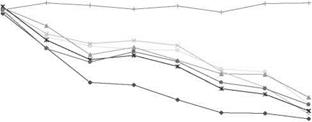 2
2
1.5  1
1
0.5
0
N is significantly (P<0.05) different to all other products
at days 3, 5, 7, 10 and 14
Figure 19 Results from the treatment phase of a Kligman-type regression study (products applied twice-daily at 2 mg/cm2 to randomized sites on the outer, lower leg of female subjects [n= 36] with inclusion of a no-treament control). Products represented high-efficacy commercial moisturizers with ingredients of differing dry skin relief mechanism. Abbreviations: NT, no treatment control; N, niacinamide-containing lotion; A, lactic acid-containing moisturizer; other product codes represent commercial products with high loadings of traditional humectants and emollients (including glycerin and petrolatum). Source: From Ref. 2.
Product V2 Product D Product K Product G Product A No treatment
![]()
![]()
![]()
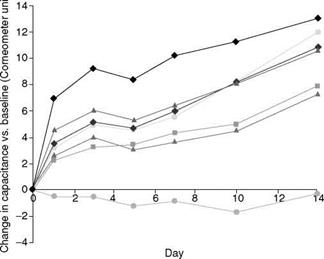 sensitive skin with a concomitant improvement in stinging score. Ertel et al. (135) observed similar improvements in barrier functionality together with an increased SC turnover rate using a 2% niacinamide cream. Draelos et al. (136) similarly observed a significant improvement in SC barrier function and improvement in global skin condition in subjects with stage 1/11 Rosacea.
sensitive skin with a concomitant improvement in stinging score. Ertel et al. (135) observed similar improvements in barrier functionality together with an increased SC turnover rate using a 2% niacinamide cream. Draelos et al. (136) similarly observed a significant improvement in SC barrier function and improvement in global skin condition in subjects with stage 1/11 Rosacea.
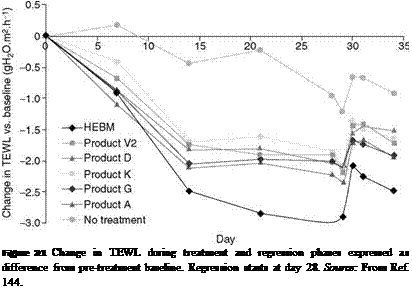
Topical application of phytosphingosine and its derivatives have also been shown to increase SC ceramide levels and barrier function (137). This is especially important as the phytosphingosine-containing ceramides are deficient in dry skin. Although increases in the total levels of ceramides were observed, greater increases in CER EOS and CER AS were found when combined with juniperic acid and linoleic acid. Linoleic acid on its own has
HEBM Product V2 Product D Product K Product G Product A No treatment
![]()
![]()
![]()
![]()
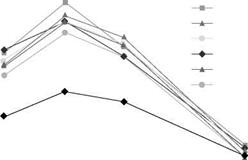
![]()
![]()
![]()
![]()
![]()
![]()

![]()

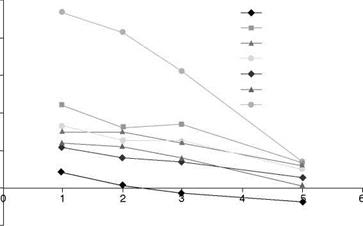 HEBM Product V2 Product D Product K Product G Product A No treatment
HEBM Product V2 Product D Product K Product G Product A No treatment
also been proven to be incorporated into CER EOS in vivo (138) which is obviously important for the lipid phase behavior and skin properties. Lipid fractions from unsaponifiable fractions of avocado (furanyl-8-11- cis heptadecadiene) and sunflower oleodistillates (mainly linoleic and oleic acids) also increase ceramide and cholesterol biosynthesis ex vivo (139).
The effects of increasing SC lipid levels by stimulating ceramide biosynthesis have been investigated extensively by Denda et al. (140). Histamine antagonists and certain fragrances stimulate lipid biosynthesis. Mixtures of magnesium and calcium salts have also been shown to accelerate skin barrier recovery and improve surfactant-induced or tape stripping-induced dry skin. Although these studies indicate the importance of these ions for epidermal homeostasis, more work is needed with cosmetic formulations. More recently, it has been demonstrated that gamma-aminobutyric acid (GABA) type A
13
![]()
![]()
![]()

![]()
![]()
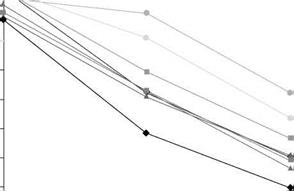 0
0
c
n>
-0.02
|
I -0.04-
|
|
CL
|
|
О |
receptor agonists, musimol, and isoguvacine accelerate barrier recovery following barrier disruption. Conversely, ATP (purinergic) receptor (P2X) agonists delay barrier recovery whereas P2Y antagonists accelerate it. These also reduced the epidermal hyperproliferative response induced by acetone treatment under low environmental humidity (Table 2).
Other agents have been shown to stimulate ceramide synthesis in vitro. Lipoic acid and N-acetylcysteine were also reported to increase ceramide synthesis in vitro (141). Recently vitamin C has been shown to activate PKC and increase ceramide synthesis and improve the ceramide subspecies profile in epidermal skin equivalents (142). Yarosh and Brown (143) also demonstrated that Ursolic acid increased ceramides in human skin. For a complete analysis of agents that stimulate lipid biosynthesis see Table 2.
Very recently, exploiting its lipogenesis and differentiation enhancing effects, niacinamide has been introduced into lotions, together with glycerol and other NMF components, that effectively alleviate dry skin and provide a significant improvement in SC barrier function (144). These lotions have been shown to be more effective than traditional emollient and lactic acid-containing moisturisers in relieving dry skin in the treatment phase of a typical Kligman-type regression study (Fig. 19), together with the changes in moisturization (Fig. 20) and barrier function (Fig. 21) as well as improving resistance to SLS and tape stripping-induced barrier perturbation (Fig. 22) (101). The improvement in desquamation was also proven with a dansylchloride exfoliation test (Fig. 23).
